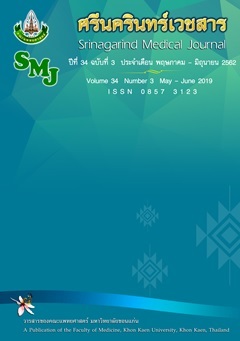ความสัมพันธ์ระหว่างความรู้ ทัศนคติ และพฤติกรรมการพยาบาลของพยาบาลในการดูแลภาวะสับสนเฉียบพลันหลังผ่าตัดในผู้สูงอายุ
คำสำคัญ:
การพยาบาล; ความรู้; ทัศนคติ; ภาวะสับสนเฉียบพลันหลังผ่าตัด; ผู้สูงอายุ, nursing care; knowledge; attitude; post-operative delirium; the elderlyบทคัดย่อ
หลักการและวัตถุประสงค์: พยาบาลมีบทบาทสำคัญที่ต้องตระหนัก เฝ้าระวัง ป้องกัน และจัดการภาวะสับสนเฉียบพลันหลังผ่าตัดในผู้สูงอายุ การศึกษาครั้งนี้มีวัตถุประสงค์เพื่อศึกษาระดับและความสัมพันธ์ระหว่างความรู้ ทัศนคติ และการปฏิบัติของพยาบาลในการดูแลภาวะสับสนเฉียบพลันหลังผ่าตัดในผู้สูงอายุ
วิธีการศึกษา: เป็นการวิจัยเชิงสหสัมพันธ์ ประชากรที่ศึกษาคือพยาบาลวิชาชีพในแผนกการพยาบาลศัลยกรรมและออร์โธปิดิกส์ โรงพยาบาลศรีนครินทร์ คณะแพทยศาสตร์ มหาวิทยาลัยขอนแก่น จำนวน 94 ราย เก็บข้อมูลด้วยแบบวัดความรู้ แบบสอบถามทัศนคติ และแบบสอบถามพฤติกรรมของพยาบาลในการดูแลภาวะสับสนเฉียบพลันหลังผ่าตัดในผู้สูงอายุ มีค่าความเที่ยงเท่ากับ 0.70, 0.83 และ0.91 ตามลำดับ วิเคราะห์ข้อมูลโดยใช้สถิติเชิงพรรณนา สถิติ Spearman’s Rho
ผลการศึกษา: อัตราการตอบกลับร้อยละ 97.92 (96/94) พยาบาลมีความรู้ระดับดีร้อยละ 78.7 ทัศนคติในทางที่ดีร้อยละ 44.7 และปฏิบัติการพยาบาลในการดูแลภาวะสับสนเฉียบพลันหลังผ่าตัดในผู้สูงอายุเป็นประจำร้อยละ 79.8 ความรู้และทัศนคติไม่มีความสัมพันธ์กับพฤติกรรมของพยาบาลในการดูแลภาวะสับสนเฉียบพลันหลังผ่าตัดในผู้สูงอายุ (p = .111, และ .913 ตามลำดับ)
สรุป: พยาบาลส่วนใหญ่มีความรู้ระดับดี ทัศนคติในทางที่ดีและการปฏิบัติของพยาบาลในการดูแลภาวะสับสนเฉียบพลันหลังผ่าตัดในผู้สูงอายุมีการดูแลเป็นประจำ ดังนั้นควรมีการออกแบบการอบรมเชิงปฏิบัติการให้ความรู้ร่วมกับการเสริมสร้างทัศนคติให้กับพยาบาลอย่างสม่ำเสมอ ต่อเนื่อง เพื่อคุณภาพการดูแลผู้สูงอายุที่เข้ารับการผ่าตัดต่อไป
References
2. Rudolph JL, Marcantonio ER. Review articles: postoperative delirium: acute change with long-term implications. Anesth Analg 2011; 112: 1202–11.
3. Quinlan N, Rudolph JL. Postoperative delirium and functional decline after noncardiac surgery. J Am Geriatr Soc 2011; 59: S301–4.
4. Rizk P, Morris W, Oladeji P, Huo M. Review of postoperative delirium in geriatric patients undergoing hip surgery. Geriatr Orthop Surg Rehabil 2016; 7: 100–5.
5. Muangpaisan W, Wongprikron A, Srinonprasert V, Suwanpatoomlerd S, Sutipornpalangkul W, Assantchai P. Incidence and risk factors of acute delirium in older patients with hip fracture in Siriraj hospital. J Med Assoc Thai 2015; 98: 423–30.
6. Inouye SK, Robinson T, Blaum C, Busby-Whitehead J, Boustani M, Chalian A, et al. Postoperative delirium in older adults: best practice statement from the American Geriatrics Society. J Am Coll Surg 2015; 220: 136–148.e1.
7. Siddiqi N, Harrison JK, Clegg A, Teale EA, Young J, Taylor J, et al. Interventions for preventing delirium in hospitalised non-ICU patients. Cochrane Ddatabase Syst Rev 2016; 3: CD005563.
8. Yang, Y.-H. Comprehension and Knowledge about Delirium in Nurses Working at Long-Term Care Hospitals or General Hospitals. J Korean Acad Soc Nurs Educ 2010; 16: 312–20.
9. Voyer P, Richard S, Doucet L, Danjou C, Carmichael PH. Detection of delirium by nurses among long-term care residents with dementia. BMC Nurs 2008; 7: 4.
10. Ajoy Sunil A. An evaluation of nursing practices regarding delirium assessments in adult critical care units in Western seaboard region of Ireland [Internet]. National University of Ireland Galway; 2014. [cited February 7, 2018]; Available from: http://hdl.handle.net/10147/336019
11. Hare M, Wynaden D, McGowan S, Landsborough I, Speed G. A questionnaire to determine nurses’ knowledge of delirium and its risk factors. Contemp Nurse 2008; 29: 23–31.
12. Kim MY, Eun Y. Knowledge, performance and stress about care for delirium orthopedic hospital nurses. J Muscle Jt Heal 2013; 20: 72–80.
13. Lee KH, Park ML, Kim GY. A study of knowledge, recognition and practice about delirium in general hospital nurses. Adv Sci Technol Lett 2016; 122: 56-9.
14. Mouchoux C, Fassier T, Rippert P, Comte B, Castel-Kremer E, Barth X, et al. Nursing staff knowledge on postoperative delirium in older inpatients: an exploratory survey. Adv Practice Nurs 2015; 1: 102.
15. Park YS, Kim K, Song K, Kang J. A preliminary survey of nurses’ understanding of delirium and their need for delirium education: in a university hospital. J Korean Acad Nurs 2006; 36: 1183–92.
16. Uppanisakorn S, Seangnhern U, Intaraksa P, Chinnawong T. Factors related to the knowledge about delirium in critical ill patients among nurse. Thai J Crit Care Med 2010; 17: 6–12.
17. Eastwood GM, Peck L, Bellomo R, Baldwin I, Reade MC. A questionnaire survey of critical care nurses’ attitudes to delirium assessment before and after introduction of the CAM-ICU. Aust Crit Care 2012; 25:162–9.
18. Tangchonlatip K, Vapattanawong P, Chamchan C, Kanungsukkasem U, Vong-Ek P, Punpuingm S. Value of Thai elderly: perspectives from two genrations. In: Thaweecit S, Boonyamanond, S, Editors. Population and social 2010: Value of the elderly from the eyes of Thai society. NakhonPathom: Institute for population and social research, 2010: 29–61.
19. Flagg B, Cox L, Mcdowell S, Mwose JM, Buelow JM. Nursing identification of delirium. Clin Nurse Spec 2010; 24: 260-6.
20. Hamdan-Mansour AM, Farhan NA, Othman EH, Yacoub MI. Knowledge and nursing practice of critical care nurses caring for patients with delirium in intensive care units in Jordan. J Contin Educ Nurs 2010; 41: 571–6.
21. Liu Y-E, Norman IJ, While AE. Nurses’ attitudes towards older people and working with older patients: an explanatory model. J Nurs Manag 2015; 23: 965–73.
22. Devlin JW, Fong JJ, Howard EP, Skrobik Y, McCoy N, Yasuda C, et al. Assessment of delirium in the intensive care unit: nursing practices and perceptions. Am J Crit care 2008; 17: 555–65.
23. Nursing department Srinagarind hospital Faculty of Medicine Khon Kaen university. Manual of nursing care system for Hospitalized elderly patients. Khon Kaen: Khon Kaen university, 2013.
24. Bandura A. Social foundations of thought and action: a social cognitive theory. Englewood Cliffs, NJ: Prentice-Hall, 1986.
25. de Guzman AB, Jimenez BCB, Jocson KP, Junio AR, Junio DE, Jurado JBN, et al. Filipino nursing students’ behavioral intentions toward geriatric care: a Structural Equation Model (SEM). Educ Gerontol 2013; 39: 138–54.
26. Lovell M. Caring for the elderly: changing perceptions and attitudes. J Vasc Nurs 2006; 24: 22–6.



